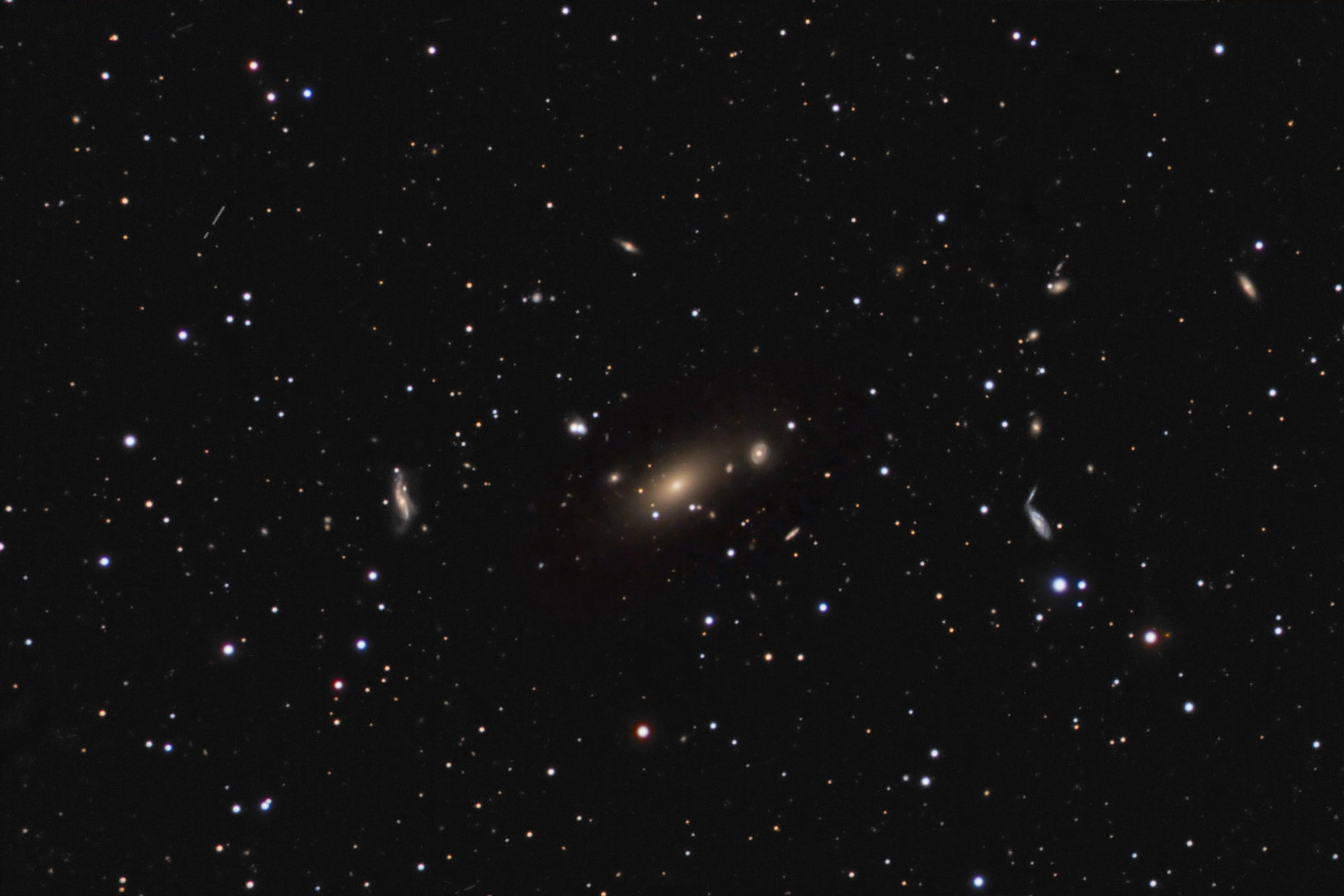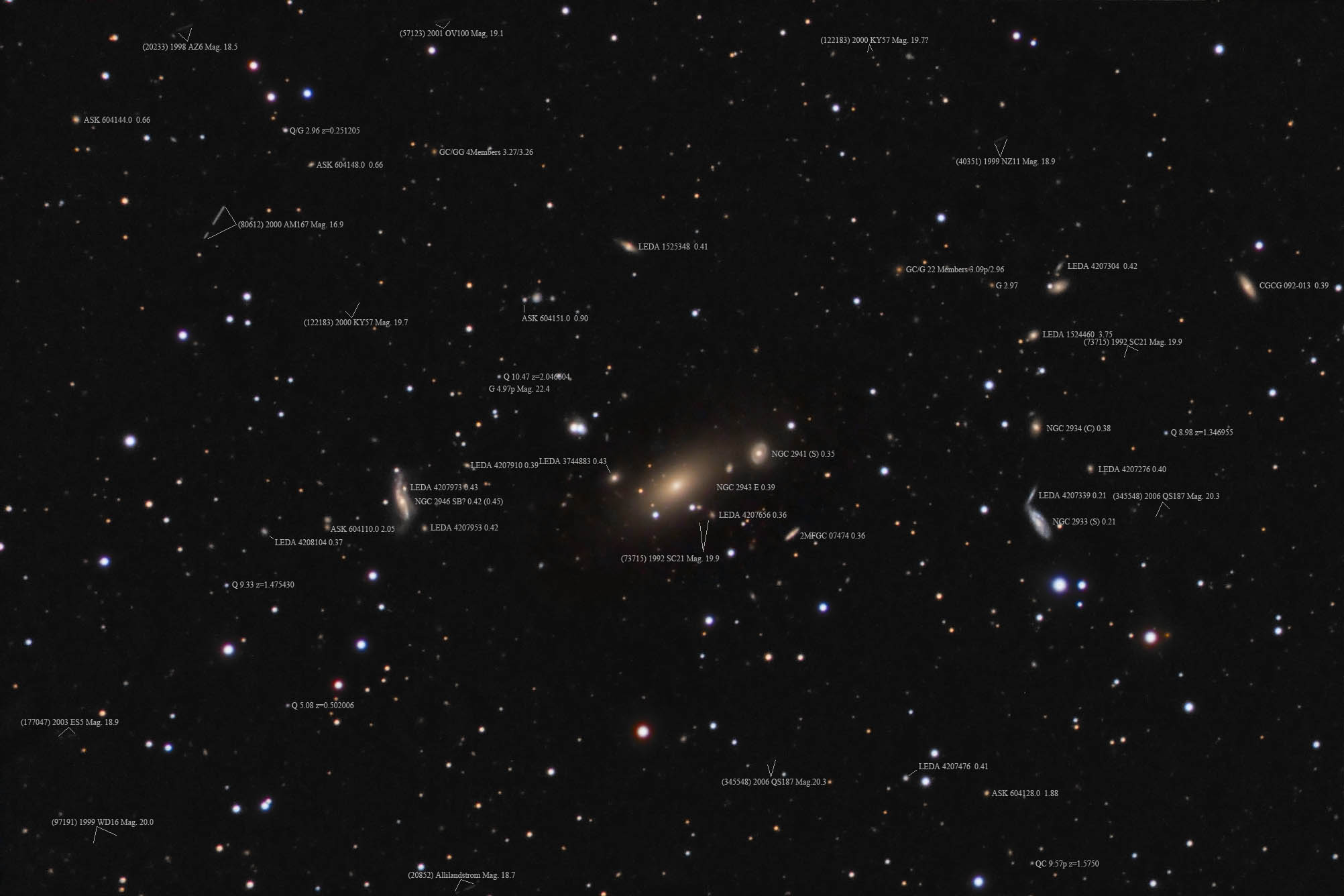| Description | Images |
Object name: NGC2943Designation(s): NGC2943, NGC2933, NGC2934, NGC2941, NGC2946, NGC 2943 anchors the WBL 229 galaxy group about 400 million light-years distant in western Leo. While the group is listed at NED as having only 4 members there are many galaxies at about the same redshift as NGC 2943 as shown in the annotated image. The galaxy is a huge elliptical. I can trace it out to about 330 arc seconds on the original FITS stack. At 390 million light-years that is over 600,000 light-years in diameter. It dwarfs more normal sized galaxies in the group and those like NGC 2933 at half that distance. The field contains 4 NGC galaxies at about 400 million light-years, NGC 2934, 2941, 2943 and 2946. With NGC 2933 and its companion LEDA 4207399 at half that distance. Related Designation(s):1RXS J093833.9+170205, 2MASS J09375499+1700526, 2MASS J09375514+1703162, 2MASS J09382420+1702400, 2MASS J09383288+1701525, 2MASS J09390156+1701309, 2MASX J09375514+1703168, 2MASX J09382422+1702398, 2MASX J09383289+1701527, 2MASX J09390153+1701305, 2MASXi J0937551+170315, 2MFGC 07484, AGC 190854, AKARI J0939013+170130, ASK 604122.0, ASK 604155.0, ASK 604172.0, CGCG 092-015 NED01, CGCG 092-017, CGCG 092-019, CGCG 092-020, CGCG 0935.2+1715 NED01, CGCG 0935.6+1717, CGCG 0935.8+1716, CGCG 0936.3+1715, ECO 04876, ECO 04921, FIRST J093832.8+170152, GALEXASC J093755.13+170315.8 , GALEXASC J093824.25+170239.7 , GALEXASC J093901.57+170133.3 , HOLM 136A, HOLM 136B, IRAS 09362+1715, IRAS F09356+1716, IRAS F09362+1715, LEDA 1523531, MCG +03-25-008, MCG +03-25-009, MCG +03-25-011, MCG +03-25-013, NGC 2933, NGC 2934, NGC 2941, NGC 2943, NGC 2946, NGC2933, NGC2934, NGC2941, NGC2943, NGC2946, NPM1G +17.0268, NSA 108807, NSA 108823, NSA 108832, NSA 135988, NSA 135993, NVSS J093901+170131, PGC 027436, PGC 027470, PGC 027482, PGC 027521, SDSS J093755.15+170316.1, SDSS J093755.16+170316.2, SDSS J093824.19+170240.0, SDSS J093824.20+170240.0, SDSS J093824.21+170240.0, SDSS J093832.86+170152.6, SDSS J093832.87+170152.6, SDSS J093832.87+170152.7, SDSS J093832.89+170152.6, SDSS J093901.57+170131.1, UGC 05132, UGC 05136, UGC 05143, USGC U242 NED01, USGC U242 NED02, USGC U242 NED04, UZC J093755.0+170053, UZC J093824.2+170238, UZC J093832.9+170152, UZC J093901.6+170131, WBL 229-001, WBL 229-002, WBL 229-003, WBL 229-004, [PJY2015] 587742013267181662 , [TTL2012] 264444, [TTL2012] 561607, [TTL2012] 562066, |

